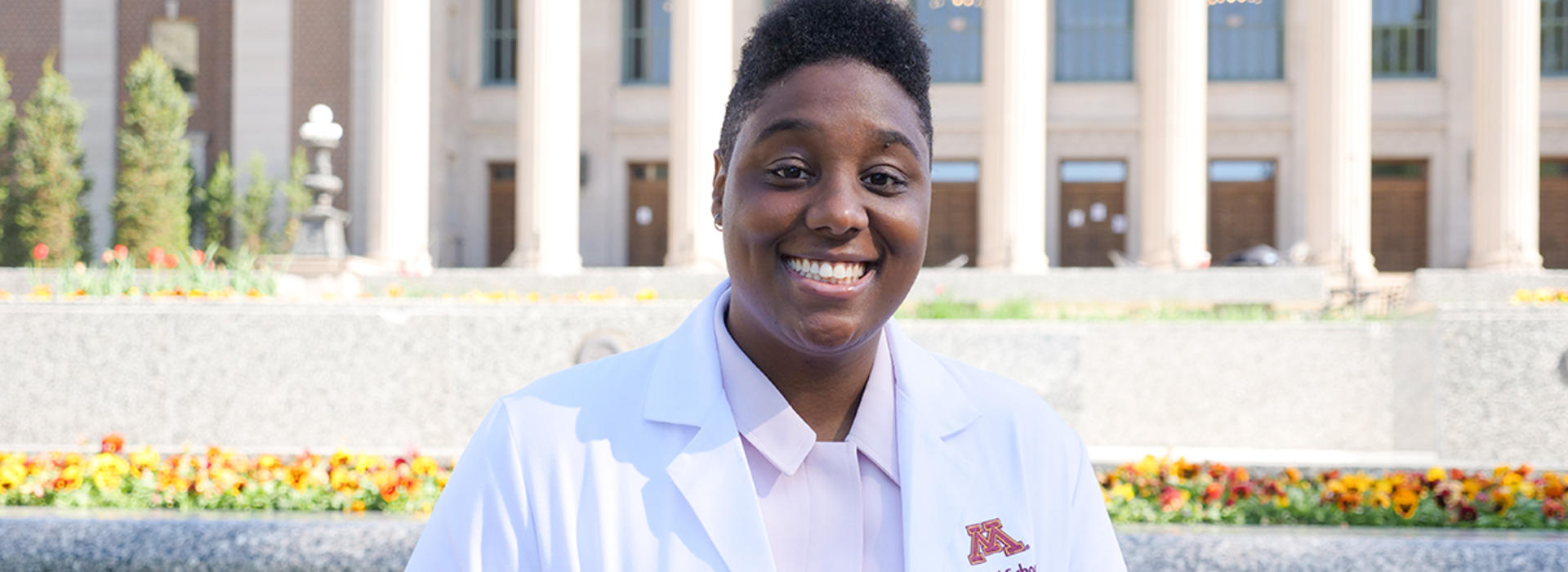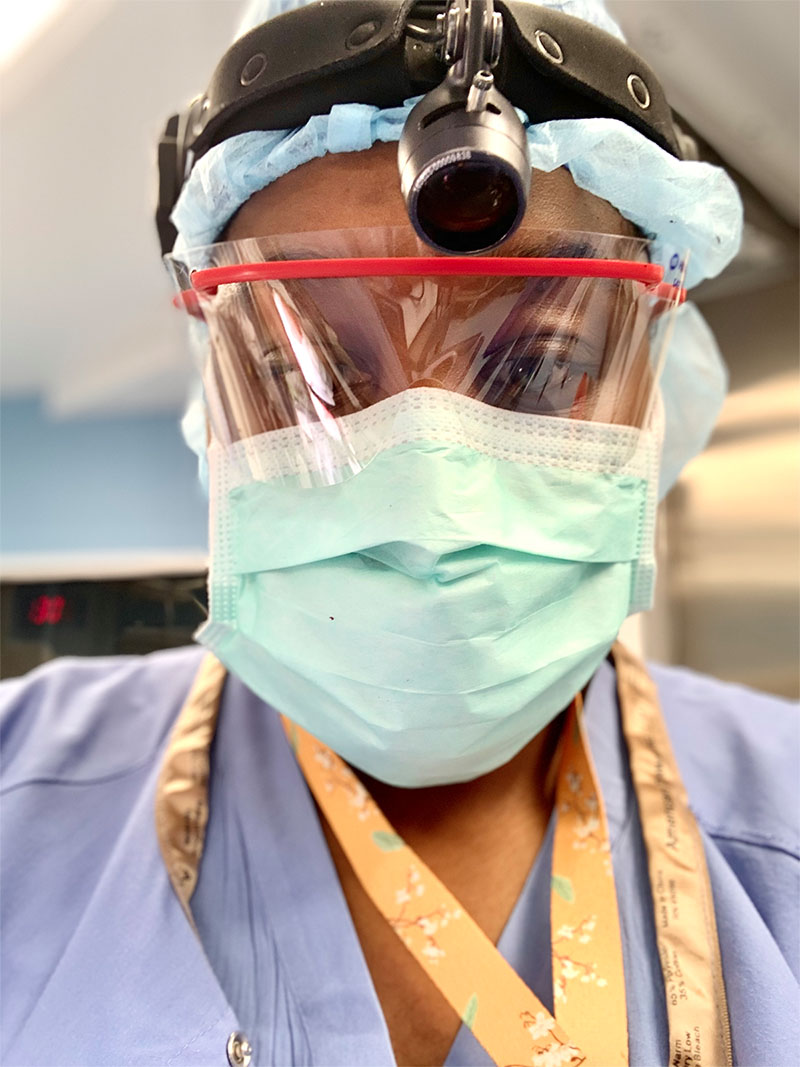
Meet the Next Generation of Neurosurgery
Meet the Next Generation of Neurosurgery
Cleresa Roberts Shares Her Journey in Becoming Part of the 2021 Incoming Class of Neurosurgery Residents
Read time: 3.5 minutes
As Cleresa Roberts eagerly slipped into her white coat in 2016, then a new student at the University of Minnesota Medical School, the idea of pursuing the field of surgery interested her.
“But, neurosurgery was definitely not on my brain,” she laughed. “No pun intended.”
Nor did she intend to become a trailblazer in the discipline. When Roberts graduates this month with two degrees – a medical degree and a Master of Business Administration from the U of M’s Carlson School of Management – she will move to Virginia to begin her residency in neurosurgery as one of only two Black, female medical students in the United States to have matched into a North American neurosurgical residency program.
While the U of M Medical School did help train and graduate Alexa Canady, MD, the first-ever Black, female neurosurgeon, in 1981, much work has yet to be done – by all medical schools – to close the diversity gap among neurosurgery physicians. According to a recent historical overview published in the World of Surgery, only 6% of practicing neurosurgeons are women and just 4% are Black or African American. Combining race and gender, students like Roberts almost don’t exist – just 33 practicing neurosurgeons in the United States identify as Black females, making up 0.6% of the current workforce.
“It’s terrifying,” Roberts admitted. “I didn’t come in with the idea that I would be in this position, especially given my experience just trying to get into medical school. But, as soon as I recognized the role I had… I feel like I fought for this degree.”
The Motivation

A younger Roberts loved science, and she loved helping people. At the time, she couldn’t quite identify the type of career that would blend those two passions. Then, her father fell ill – and almost died – after reaching a blood sugar level of more than 800.
“He had diabetes, and he didn’t know,” Roberts said. “Most of my family comes from impoverished areas and has limited access to healthcare. After almost losing my Dad, this was a turning point for me as I really started to become aware of health disparities and the impacts of inequity. Within my family, there definitely exists some mistrust of medicine, and it highlights the importance of having physicians that look like the diverse populations in America.”
With a path charted, she began her educational journey in Ohio, surrounding herself with a group of fellow Black undergraduate students who all dreamed of studying medicine.
“There were five or six of us, and we all wanted to get into medical school,” Roberts recalled. “But, I was the only one to make it. Not that they didn’t try, but those barriers happen, and it just didn’t work out – even for me initially. The MCAT (Medical College Admission Test) and lack of mentorship was a huge barrier for me, so I had to work a couple years after undergrad to boost my resume.”
By 2016, after casting her net far and wide, Roberts happily accepted an offer to attend the U of M Medical School.
“That experience with my classmates has really given me the drive to make the system better, and my education at the U of M Medical School has really taught me what I’m capable of,” she said.
The Education

Roberts, in her second semester of medical school, remembers her first day in class – and first exposure ever – studying the concept of neuroscience.
“I really loved it, and I got a 100% in that class with the material,” she said. “During our second year, we had a neuropath component, and I really loved learning about the diseases, pathology and the overall nervous system, but still, neurosurgery never came to mind.”
By her third year, the Medical School curriculum empowered Roberts to “pick a lane” for a three-week period. She chose neurosurgery out of curiosity.
“And, I fell in love with it,” she said. “They were doing a subdural hematoma evacuation, and as a medical student, I got to do a burr hole and scrub in on the case. I ended up going back after those three weeks during a full week that I had off to get more exposure, and I absolutely knew it was what I wanted to do.”
But, as she found her home in medicine, she began noticing all too familiar patterns.
“I’ve often been the only Black woman in hospitals and on teams, and it was really hard to find mentors,” Roberts said. “I began realizing, even more deeply, the importance of having this ‘seat at the table.’ That’s why I decided to get my MBA.”
After completing her first three years of medical school, Roberts paused her medical education to begin the first year of her MBA program. Then, during this past academic year, she completed coursework on both degrees concurrently. Not to mention, she served as a medical tutor and as president of the Medical School’s chapter of the Alpha Omega Alpha Honor Medical Society.
“I needed to bolster my skill set in understanding minority leadership and the business of healthcare,” she said. “We don’t get a lot of that in medical school, and I really believe in order to understand healthcare and make a difference, you have to know how it was all created and operates.”
The Privilege to Practice
Roberts says that although it wasn’t easy, she feels confident going into residency with what she has learned from the U of M Medical School. Practicing in medicine, especially in neurosurgery, is “a privilege.”
“Being a neurosurgeon comes with this privilege of taking care of some of the most ill patients in the hospital,” she said. “Neurosurgery is not exempt from health inequities. That’s why I want to build my career in academic medicine, so that I can not only take care of my patients but also advance their health through research. I definitely see myself doing that from a leadership position – maybe even as a dean of a medical school one day.”
That privilege Roberts describes is felt even deeper as she acknowledges her place in history – a soon-to-be, Black, female neurosurgeon, but also the great ancestor of slaves and the granddaughter of sharecroppers.
“Where I am is a testament to my family, who had the strength to endure, and I could not have done any of this without them. It’s important for me to remember that,” she said. “My goal is to make a difference, where what I discover can be used as a model for all of medicine because the system has to change.”